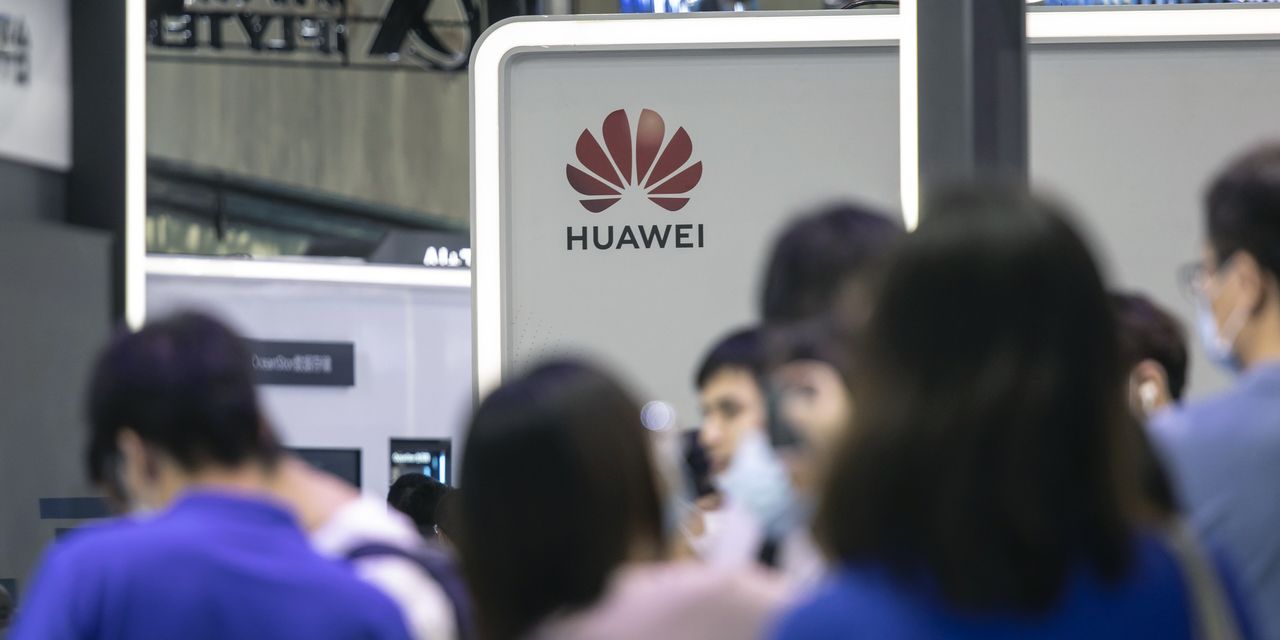The U.S. and many of its allies have restricted the use of 5G cellular equipment made by China’s Huawei Technologies Co. Now Beijing is doing the same to Huawei’s Western rivals.
China Mobile Ltd.
941 1.22%
, a government-owned wireless carrier that is the world’s biggest by subscribers, awarded in July 5.4% of its latest 5G-equipment tenders to non-Chinese suppliers, down from 11% in its previous round in 2020.
The biggest loser was Sweden’s
Ericsson
ERIC 0.95%
AB, which after winning all of that 11% last year, fell to just 1.9% in this round. A Chinese state-controlled media outlet described the market-share loss as retaliation for Sweden’s decision to ban Huawei and China’s ZTE Corp. from its 5G networks.
China Mobile representatives didn’t respond to a request for comment.
Just as the internet is splitting between a largely censored Chinese web and another led by American companies, so is the infrastructure behind it.
The $35-billion global cellular-equipment market can be divided into three segments of roughly equal size: China, the U.S. and the rest of the world. China increasingly relies on Chinese equipment. The U.S. has effectively banned Huawei, the world’s biggest cellular-equipment maker, from major networks for years over concerns that Beijing could tap the company to spy. Huawei and Beijing say the concerns are unfounded.
A good chunk of the rest of the world is following Washington’s lead. There are big exceptions, like Germany. Countries that have enacted or are considering restrictions against Huawei comprise more than 60% of the world’s cellular-equipment market, says research-firm Dell’Oro Group. Outside China, Ericsson and Finland’s
Nokia Corp.
NOK 0.82%
are winning deals at Huawei’s expense.
“Under the current trajectory, the telecom industry seems to be becoming more polarized between East and West,” said Simon Leopold, a telecom analyst at Raymond James.
In a tender worth about $6 billion, China Mobile awarded about 60.5% of the value to Huawei, up from 57.7% in last year’s round. It gave 31.2% to ZTE and 2.8% to smaller Chinese supplier Datang Telecom Group. Nokia won the biggest share for a foreign company, at 3.5%.
In 2020, Sweden explicitly banned Huawei and ZTE from supplying its 5G networks, going beyond European counterparts that put restrictions on the Chinese companies without naming them. Chinese officials warned that they could retaliate against Ericsson, prompting Chief Executive
Börje Ekholm
to lobby officials in the Scandinavian country to reconsider the ban.
The Global Times, a newspaper published by China’s ruling Communist Party, said this month that Ericsson’s poor showing in the China Mobile auction was “linked to the Swedish government’s arbitrary crackdown on Huawei and other Chinese firms.”
Days before China Mobile announced the winners of the 5G equipment contracts, Ericsson reported losing $300 million in second-quarter sales in China compared with a year earlier. Mr. Ekholm told analysts that he wasn’t exactly sure of the reason for the surprising loss, but predicted that Ericsson wouldn’t recoup it.
In an interview Tuesday, Mr. Ekholm said it was positive that Ericsson got a sliver of China’s latest equipment tender, rather than zero, and that the company would try to increase its market share in future tenders there.
He said the Chinese market mattered not only for its size, but because Ericsson could learn from participating in the world’s most aggressive 5G rollout. “We have to be there,” he said.
Nokia’s award of roughly 4% was an improvement after it got shut out of China Mobile’s 5G cellular-equipment tender in 2020, when it was still recovering from a blunder in chip procurement that made its equipment more expensive and less attractive to wireless carriers. Some analysts said it was a surprise and disappointment that Nokia didn’t take all of Ericsson’s market share in the latest tender.
SHARE YOUR THOUGHTS
Would you be worried if your local 5G network was built with China-made gear? Join the conversation below.
The small market share means Ericsson and Nokia will mostly miss out on the world’s most aggressive 5G rollout this year. China’s vice minister of industry and information technology said in July that the country had built 916,000 5G cellular sites, which accounts for about 70% of the world’s total, and aims to have 560 million 5G wireless subscribers by the end of 2023.
As the Chinese networks near completion around 2023, restrictions on Huawei outside China will increasingly benefit Ericsson and Nokia, as Europe and other parts of the world accelerate their 5G rollout, Raymond James’ Mr. Leopold said.
Both Ericsson and Nokia have benefited from Huawei’s woes. Nokia CEO
Pekka Lundmark
said earlier this week that the Finnish company has won roughly half of the potential deals that have stemmed from wireless carriers switching equipment suppliers for “politically driven reasons.”
Nationalism isn’t new in the telecom space. Two decades ago, the U.S. favored Lucent, Canada preferred
Nortel
and France favored Alcatel, Mr. Leopold said. All three hit tough times, in part because Huawei and ZTE began selling competitive products at lower prices, and ended up being absorbed by Ericsson or Nokia. Those companies are today’s only major Western rivals to Huawei.
Ericsson had a market share of more than 25% in China as recently as 2011, but it has fallen since. The European Union and China in 2014 struck a handshake deal to reserve roughly 25% of the Chinese telecom-equipment market for Ericsson and Nokia, but it was never enforced.
Since then, with the U.S. lacking its own major industry player, Washington has tried to support the Nordic companies as well as
Samsung Electronics Co.
Ltd. by offering loans to get developing countries to buy non-Chinese telecom equipment. The U.S. has also used export controls that make it hard for Huawei to buy supplies it needs for products.
Write to Stu Woo at Stu.Woo@wsj.com
Copyright ©2021 Dow Jones & Company, Inc. All Rights Reserved. 87990cbe856818d5eddac44c7b1cdeb8














































